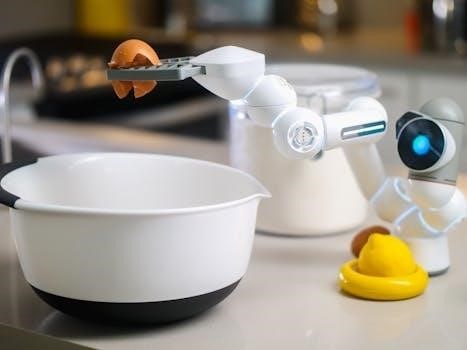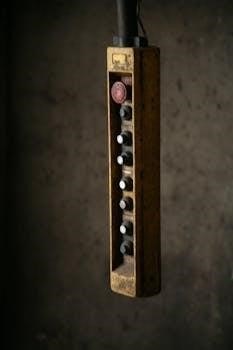power electronics pdf
What is Power Electronics?
Power electronics is a field of electrical engineering that uses semiconductor devices to control and convert electric power. It’s an interdisciplinary technology involving power semiconductor devices‚ converter topologies‚ and control strategies. The goal is efficient and reliable power conversion for various applications;
Fundamentals of Power Electronics
The fundamentals involve understanding power semiconductor devices like SCRs‚ their characteristics‚ and driving requirements. Also important are power converter topologies‚ control strategies for these converters‚ and the use of digital and analog microelectronics for control and optimization in power electronic systems.
Power semiconductor devices are the heart of power electronics‚ enabling efficient switching and control of electrical power. The first SCR was developed in late 1957‚ marking a revolution. These devices have seen tremendous improvements in power handling capabilities and switching speed. They are crucial for converting electrical power to suit specific applications‚ altering voltage‚ current‚ and frequency characteristics.
These devices are compact‚ highly reliable‚ and exhibit low losses. Understanding their physics‚ characteristics‚ drive requirements‚ and protection methods is essential for optimum utilization. Modern devices include diodes‚ transistors‚ and thyristors‚ each with unique features and applications. Silicon (Si)‚ Silicon Carbide (SiC)‚ and Gallium Nitride (GaN) are materials used.
Power semiconductor devices function as electronic switches controlling power flow. They are used in rectifiers‚ inverters‚ DC-DC converters‚ and AC-AC converters. Their ability to switch rapidly allows for efficient conversion. They are fundamental building blocks in modern power electronic systems.
Power Converter Topologies
Power converter topologies define the arrangement and interconnection of power semiconductor devices‚ inductors‚ capacitors‚ and other components to achieve desired power conversion functions. These topologies dictate how electrical energy is transformed from one form to another with high efficiency. Common topologies include buck‚ boost‚ buck-boost‚ and flyback converters for DC-DC conversion‚ as well as half-bridge‚ full-bridge‚ and multi-level inverters for DC-AC conversion.
The selection of a specific topology depends on factors like input voltage range‚ output voltage requirements‚ power levels‚ efficiency targets‚ and isolation needs. Each topology has its own advantages and disadvantages in terms of component count‚ complexity‚ control requirements‚ and performance characteristics. Understanding the principles and trade-offs associated with different topologies is crucial for designing effective power electronic converters.
Advanced simulation models and analyses are often employed to evaluate the performance of different topologies. Topologies are essential for efficient power transfer and meeting specific application requirements.
Control Strategies of Converters
Control strategies are essential for regulating the output voltage or current of power electronic converters and ensuring stable and reliable operation. These strategies involve feedback control loops that monitor the output and adjust the switching of power semiconductor devices to maintain the desired output characteristics. Common control techniques include Pulse Width Modulation (PWM)‚ which varies the duty cycle of switching signals‚ and frequency modulation‚ which adjusts the switching frequency.
Advanced control strategies‚ such as sliding mode control and model predictive control‚ are employed to improve dynamic response‚ robustness‚ and efficiency. Digital control implementations using microcontrollers or digital signal processors (DSPs) offer flexibility and programmability in implementing complex control algorithms. The control system must address challenges such as non-linearities‚ time delays‚ and disturbances to achieve optimal performance. Control circuits ensure the converters operate efficiently and meet load demands.
Effective control strategies are crucial for achieving high-performance power electronic systems that meet stringent requirements in various applications.

Key Concepts in Power Electronics
Key concepts involve power semiconductor devices‚ phase-controlled converters‚ DC to DC converters‚ inverters‚ and AC to AC converters. Understanding these elements is crucial for designing and analyzing power electronic systems for efficient power conversion.
Power Semiconductor Devices
Power semiconductor devices are fundamental to power electronics‚ enabling efficient switching and control of electrical energy. The development of these devices‚ starting with the SCR in 1957‚ has significantly improved power handling capabilities and switching speeds. Power semiconductor devices are essential components in various power electronic circuits.
These devices include diodes‚ thyristors‚ MOSFETs‚ and IGBTs‚ each with unique characteristics and applications. Understanding their physics‚ characteristics‚ drive requirements‚ and protection is crucial for optimal utilization. Selection of appropriate power devices is critical in power electronics.
These devices are used in power converters for AC to DC conversion‚ DC to DC conversion‚ DC to AC conversion‚ and AC to AC conversion. Their properties determine converter efficiency‚ switching frequency‚ and overall performance.
The choice of the device depends on the application’s voltage‚ current‚ and switching frequency requirements‚ and also affects the overall circuit design.
Phase-Controlled Converters
Phase-controlled converters are a fundamental type of power electronic circuit used for AC to DC conversion. These converters employ thyristors (SCRs) as switching devices‚ controlling the output DC voltage by adjusting the firing angle of the thyristors. They are commonly used in high-power applications such as motor drives and HVDC transmission systems.
The firing angle determines the point in the AC cycle when the thyristor is turned on‚ thus controlling the amount of power delivered to the DC side. By varying the firing angle‚ the output DC voltage can be adjusted‚ providing a means of controlled rectification.
While phase-controlled converters are relatively simple in design‚ they introduce harmonic distortion into the AC power system and have a lagging power factor. Various techniques are employed to mitigate these issues‚ such as using multiple pulse converters or adding filters to the input AC side. Phase-controlled converters can have different configurations‚ such as half-wave‚ full-wave‚ and bridge rectifiers.
DC to DC Converters
DC to DC converters‚ also known as choppers‚ are power electronic circuits that convert a DC voltage level to another DC voltage level. These converters are widely used in applications such as portable devices‚ electric vehicles‚ and power supplies. DC to DC converters employ switching elements like MOSFETs or IGBTs to efficiently step up (boost) or step down (buck) the input DC voltage.
Common topologies include buck‚ boost‚ buck-boost‚ and Cuk converters‚ each with its unique characteristics and suitability for different applications. The switching frequency and duty cycle of the switching element are critical parameters that determine the output voltage. Control techniques such as pulse-width modulation (PWM) are employed to regulate the output voltage against variations in input voltage and load current.
DC to DC converters are designed to achieve high efficiency‚ minimize switching losses‚ and provide stable output voltage regulation. Isolation can be provided using transformers‚ resulting in isolated DC to DC converters.
Inverters
Inverters are power electronic circuits that convert a DC voltage to an AC voltage. They are essential components in applications such as uninterruptible power supplies (UPS)‚ solar power systems‚ and motor drives. Inverters utilize switching devices‚ such as MOSFETs or IGBTs‚ to switch the DC voltage on and off in a specific pattern‚ generating an AC waveform.
The most common type of inverter is the pulse-width modulated (PWM) inverter‚ where the duty cycle of the switching devices is varied to control the amplitude and frequency of the AC output; Different modulation techniques‚ such as sinusoidal PWM (SPWM) and space vector PWM (SVPWM)‚ are employed to improve the quality of the AC waveform and reduce harmonic distortion.
Inverters can be classified into voltage source inverters (VSIs) and current source inverters (CSIs)‚ depending on the nature of the DC source. Furthermore‚ inverters can be single-phase or three-phase‚ depending on the application requirements.
AC to AC Converters
AC to AC converters‚ also known as AC voltage controllers or cycloconverters‚ are power electronic circuits that convert an AC voltage with a specific magnitude and frequency to another AC voltage with a different magnitude and/or frequency. These converters are widely used in applications such as motor speed control‚ lighting control‚ and induction heating.
AC voltage controllers use thyristors or triacs as switching devices to control the AC voltage applied to the load. By varying the firing angle of the thyristors‚ the RMS value of the output voltage can be adjusted. Cycloconverters‚ on the other hand‚ synthesize a new AC waveform by switching between different segments of the input AC waveform.
These converters are particularly useful in applications where variable frequency AC power is required‚ such as in large AC motor drives. However‚ cycloconverters can introduce significant harmonic distortion into the power system‚ which needs to be mitigated using appropriate filtering techniques.

Power Electronic Circuits
Power electronic circuits use electronic devices to convert electric power from one form to another. These circuits are essential for controlling and managing electrical energy in various applications‚ ensuring efficient and reliable operation.
AC to DC Converters (Rectifiers)
AC to DC converters‚ commonly known as rectifiers‚ are essential power electronic circuits that transform alternating current (AC) voltage into direct current (DC) voltage. These circuits are fundamental in numerous applications‚ including power supplies for electronic devices‚ battery chargers‚ and DC motor drives.
Rectifiers employ diodes or controlled switches like thyristors to allow current flow in only one direction‚ effectively converting the AC waveform into a pulsating DC waveform. Different rectifier configurations‚ such as half-wave‚ full-wave‚ and bridge rectifiers‚ offer varying levels of performance in terms of ripple content and efficiency. Filtering techniques‚ using capacitors and inductors‚ are often applied to smooth the pulsating DC voltage and provide a more stable DC output.
The design and selection of appropriate rectifier circuits depend on the specific requirements of the application‚ including the desired DC voltage level‚ current capacity‚ and acceptable ripple voltage. Advanced rectifier designs incorporate control strategies to improve power factor and reduce harmonic distortion.

Applications of Power Electronics
Power electronics finds widespread application across diverse industries‚ revolutionizing energy management and control. In transportation‚ power electronics enables electric vehicles‚ hybrid electric vehicles‚ and high-speed rail systems. These applications rely on efficient power conversion for motor drives‚ battery charging‚ and regenerative braking. Renewable energy systems‚ such as solar photovoltaic and wind power‚ heavily depend on power electronics for grid integration and efficient energy harvesting.
Industrial automation benefits significantly from power electronics through variable speed drives‚ which precisely control motor speed and torque‚ optimizing energy consumption and improving process control. Power supplies for computers‚ telecommunications equipment‚ and consumer electronics utilize power electronics to deliver stable and regulated DC power from AC sources.
Moreover‚ power electronics plays a crucial role in high-voltage DC (HVDC) transmission systems‚ enabling efficient and reliable long-distance power transfer. Emerging applications include smart grids‚ microgrids‚ and energy storage systems‚ further highlighting the growing importance of power electronics in modern society.
Power Electronics Design Considerations
Designing power electronic systems involves a multifaceted approach‚ considering efficiency‚ reliability‚ cost‚ and size. Selecting appropriate power semiconductor devices is crucial‚ balancing switching speed‚ voltage and current ratings‚ and thermal characteristics. Thermal management is paramount‚ requiring effective heat sinks and cooling strategies to prevent device failure.
Electromagnetic compatibility (EMC) must be addressed to minimize electromagnetic interference (EMI) generated by high-frequency switching. Control strategies play a vital role in achieving desired performance‚ stability‚ and robustness. Protection circuits are essential to safeguard against overcurrent‚ overvoltage‚ and short-circuit conditions.
Furthermore‚ component selection influences overall system performance and cost. Simulation tools are invaluable for modeling and analyzing circuit behavior‚ optimizing design parameters‚ and verifying performance. Regulatory compliance and safety standards must be met to ensure safe operation and market acceptance. Finally‚ design optimization involves trade-offs between conflicting requirements‚ such as efficiency versus size and cost versus performance.

Power Electronics and Control
Power electronics and control are inextricably linked‚ with control strategies dictating the behavior and performance of power electronic converters. Closed-loop control systems are commonly employed to regulate output voltage‚ current‚ or power‚ ensuring stable and accurate operation despite load variations or disturbances. Pulse-width modulation (PWM) is a fundamental control technique used to vary the duty cycle of switching signals‚ thereby controlling the average output voltage.
Advanced control algorithms‚ such as proportional-integral-derivative (PID) control‚ state-space control‚ and model predictive control (MPC)‚ are employed to enhance performance‚ improve dynamic response‚ and optimize system efficiency. Digital signal processors (DSPs) and microcontrollers are often used to implement complex control algorithms and provide real-time monitoring and control capabilities.
Furthermore‚ control strategies must consider stability‚ robustness‚ and transient response. Adaptive control techniques can be implemented to adjust control parameters based on operating conditions. Sensor feedback is crucial for accurate control‚ requiring careful selection and placement of voltage and current sensors. The interplay between power electronics and control is essential for achieving high-performance‚ reliable‚ and efficient power conversion systems.
